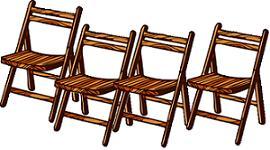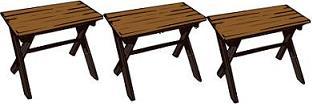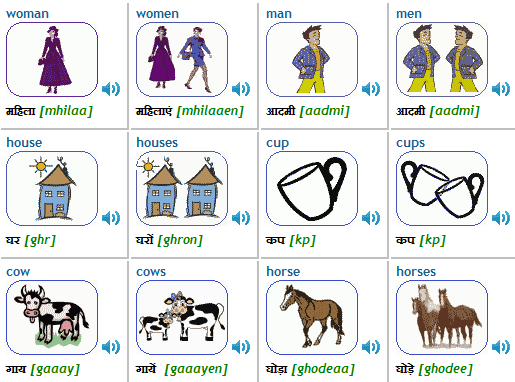Masculine Nouns
If the noun ends with आ aa then drop the आ aa and add ए e.
If not then the word doesn’t change at all!
Feminine Nouns
If the noun ends with ई ee then drop the ई ee and add इयाँ iyaan.
If not then simply add एँ en to the end!
Masculine Nouns
For Masculine Type 1 Nouns: (If the noun ends with आ -aa)
Singular Case.
We simply drop the आ aa from the end of the noun and add an ए e. So for example…

लड़का larkaa - ‘Boy’ in the oblique case becomes लड़के larke.

केला kelaa - ‘Banana’ in the oblique case becomes केले kele.
-------------------------------------------------------------------------------------------------------------------
Plural case.
Here We simply drop the ए e from the end of the noun and add an ओं on. So for example, looking at the same words just above, we have…

लड़के larke - ‘Boys’ in the oblique case becomes लड़कों larkon.

केले kele - ‘Bananas’ in the oblique case becomes केलों kelon.
Phew got that so far? Can you see that in fact the oblique case of the singular form is actually the same as the plural form of the word? That can make it a little confusing so try not get mixed up! Ready to carry on?
--------------------------------------------------------------------------------------------------------------------
For Masculine Type 2 Nouns: (If the noun ends with anything else)
Singular Case.
This one is the easiest ever - the word doesn’t change at all! So for example…

पलंग palang - ‘Bed’ in the oblique case stays exactly the same!
---------------------------------------------------------------------------------------------------------------
Plural Case:
This case is also quite straight forward, we simply add औं on to the end of the word! So we have, for example…

पलंग palang - ‘Beds’ in the oblique case becomes पलंगों palangon

अनानास anaanaas - ‘Pineapples’ in the oblique case becomes अनानासों anaanaason
Phew are you still following? That’s all Masculine nouns done so we’re half way there! I know this lesson is very long but don’t worry we can do it! Ready to learn about Feminine nouns? Great, here goes!
****
Feminine Nouns
For Feminine Type 1 Nouns: (If the noun ends with ई -ee)
Singular Case:
This is another super easy one - the word doesn’t change at all! So for example…

चाबी caabee- ‘Key’ in the oblique case stays exactly the same
--------------------------------------------------------------------------------------------------------------------------
Plural Case:
In this case we drop the इयाँ iyaan from the end of the word and add इयों iyon. So for example…

चाबियाँ caabeeyaan - ‘Keys’ in the oblique becomes चाबियों caabeeyon

कुरसियाँ kursiyaan - ‘Chairs’ in the oblique becomes कुरसियों kursiyon
---------------------------------------------------------------------------------------------------------------------
For Feminine Type 2 Nouns: (If the noun ends with anything else)
Singular Case:
This is another super easy one because the word doesn’t change! For example…

किताब kitaab - ‘Book’ stays exactly the same in the oblique!
-------------------------------------------------------------------------------------------------------------------------
Plural Case:
Here we simply drop the एँ en from the end of the word and add ओं on! So for example…

किताबें kitaaben - ‘Books’ in the oblique becomes किताबों kitaabon

मेज़ें mezen - ‘Tables’ in the oblique becomes मेज़ों mezon
Like the many prepostitions in English (e.g. in, at, on, under, below, of etc.) in Hindi there exist the so called postpositions, playing the same role as the English prepostitions, having the same meaning, but with the only difference that they stay after the noun not before it. For example in English we say "In London", but in Hindi that would be "London in" (London men).
In Hindi there are two cases: The Direct case and The Oblique case. When a word is used with a postposition it is in the Oblique case, in all other cases it is in the Direct case. The Direct case is kind of the same case as Nominative in many European languages. Here are some postpositions:
में(me~) = In
से (se) = From
का (ka) = Of
को (ko) = Not really translatable. Used to build Dative and Accusative. I'll explain a little below.
In the previous lessons, I gave many nouns. Their forms are the main forms, i.e. they're in the Direct case. I explained also that masculine nouns ending in -a become in the plural the ending -i. That's the general rule. However there are words, which do not end in -a and I havn't explained the plural of feminine, so here it goes:
Singular and Plural of Nouns in the Direct Case:
Masculine: Ending in -a
Singular: लडका (larka) = boy
Plural: लडके (larke) = boys
Masculine: Ending in other vowel (very few):
Singular: गुरु (guru) = teacher
Plural: गुरु (guru) = teacher
Masculine: Ending in a consonant
Singular: दोस्त (dost) = friend
Plural: दोस्त (dost) = friends
Feminine: Ending in -i
Singluar: लडकी (larki) = girl
Plural: लडकिया (larkiya) = girls
Feminine: Ending in a consonant
Singular: किताब (kitab) = book
Plural: किताबें (kitabe~) = books
Feminine: Ending in -a or -u
Singular: आध्यापीका (adhyapika) = female teacher
Plural: आध्यापीकाएं (adhyapikae~) = female teachers
All the sentences I gave in past lessons can be easily turned into plurals now or in some cases the sentences are even in plural since some words don't change in plural. Let me show you some examples:
लडकिया अच्छी रोटी खातीं हैं. (larkiya acchi roti khati~ hai~). = The girls eat tasty bread.
लडके अच्छी रोटी खाते हैं. (larke acchi roti khate hai~) = The boys eat tasty bread.
ये बडे घर हैं. (Ye bare ghar hai~) = These are big houses.
वे सुन्दर लडकिया हैं. (Ve sundar larkiya hai~) = Those (they) are pretty girls.
वे लडकिया सुन्दर हैं. (Ve larkiya sundar hai~) = Those girls are pretty.
Now for the oblique case. Nouns change in singular and plural in the oblique case as well. Here is the explanation (to make it easier for you, I'll use the same words as in the examples of direct case above):
Singular and Plural of Nouns in the Oblique Case:
Masculine: Ending in -a
Singular: लडके (larke)
Plural: लडकों (larko~)
Masculine: Ending in other vowel (very few):
Singular: गुरु (guru)
Plural: गुरुओं(guruo~)
(for "admi" /man/ it'll be "admiyo~" - आदमियों)
Masculine: Ending in a consonant
Singular: दोस्त (dost)
Plural: दोस्तों (dosto~)
Feminine: Ending in -i
Singluar: लडकी (ladki)
Plural: लडकियों (ladkiyo~)
Feminine: Ending in a consonant
Singular: किताब (kitab)
Plural: किताबें (kitabe~)
Feminine: Ending in -a or -u
Singular: आध्यापीका (adhyapika)
Plural: आध्यापीकाएं (adhyapikae~)
At last you know the cases in Hindi. Now (believe me) you know almost all grammar in Hindi! Congats! Now we can extend our well-know sentences and make them look really long. Let's try:
सफेद घर में लडकिया अच्छी रोटी खातीं हैं. (safed ghar men larkiya acchi roti khati~ hai~). = The girls eat tasty bread in the white house.
मैं कमरे नें ठण्डा पानी पी रहा हूँ और लडकी अच्छी राटी खा रही है. (mai~ kamre me~ thanda pani pi raha hu~ aur larki acchi rati kha rahi hai). = I'm drinking cold water in the room and the girl is eating tasty bread.
etc. The point is, whenever you wanna say "in", "at", "on", "of" etc of something, you have to use the oblique case, since you use the word with a postposition. Note for example how it is: "kamre me~", not "kamra me~", because we use the postposition "in" (me~).
Now I want to explain you the use of the postposition particle "ka", meaning "of".
Use of the postposition "का" (ka) = OF
1. Since it's a postposition you always have to use the word preceding it in the Oblique case.
2. Second thing you have to know about it is, that it could (and should :) change to ke/ki according to the word following it (the subject).
In English we say "the house of the girl". In Hindi that should be said as "the girl of the house". In this case "the girl" should be in oblique case and house of course (since obviously is the subject) is in the direct case. Our example will be in Hindi "Ladki ka ghar" (लडकी का घर). But if we use a feminine word for a subject "ka" changes to "ki" as in "Ladki ki sari" (लडकी की साड़ी), meaning "the sari of the girl" (sari is a traditional indian female clothing). Then if we want to say "the houses of the girl" we have to say "larki ke ghar" (लडकी के घर). I think you got the idea. Now we can build even bigger sentences...
The last thing I should tell you about in this lesson is the use of the particle (postposition) "ko". It's could be translated as "to", but in some cases it shouldn't be translated at all. That's so because actually it's the accusative or dative marker. If somebody is the receiver of an action (or the verb) you have to use that particle.
Use of the postposition "को" (ko)
I'll give firstly some examples and then explain you:
लडका लडकियों को पानी देता है. (larka larkiyo~ ko pani deta hai) = The boy gives water to the girls.
लडका लडकियों को किताबें देता है. (larka larkiyo~ ko kitabe~ deta hai) = The boy gives the books to the girls.
मैं लडके को जानता हूँ. (mai~ larke ko janta hu~) = I know the boy.
मैं लडकी को जानता हूँ. (mai~ larki ko janta hu~) = I know the girl.
मैं लडकों को जानता हूँ. (mai~ larko~ ko janta hu~) = I know the boys.
मैं लडकियों को जानता हूँ. (mai~ larkiyo~ ko janta hu~) = I know the girls.


No comments:
Post a Comment